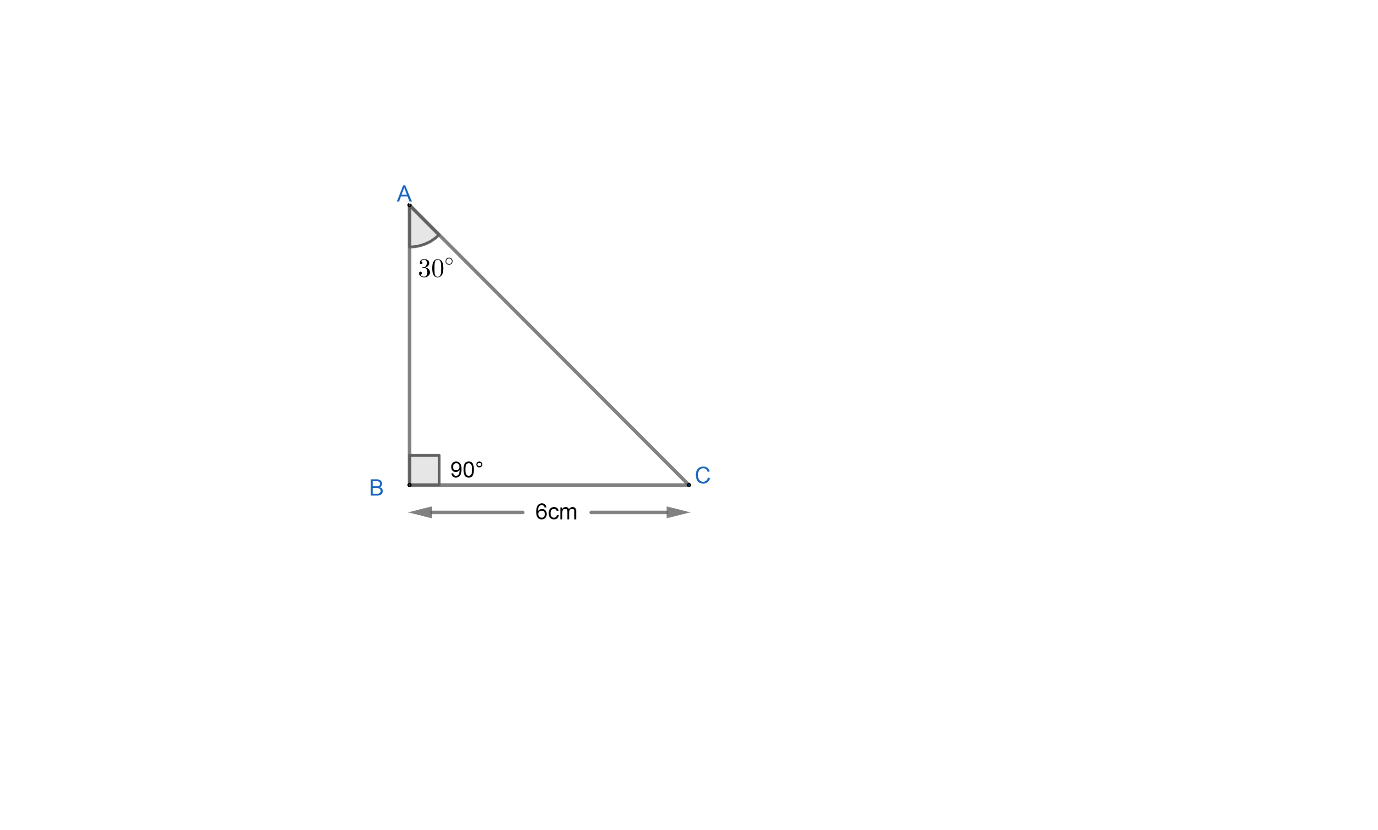
Answer
485.4k+ views
Hint: We will be using the concept of trigonometric ratios to solve the problem. We will be using the trigonometric ratio $\tan \theta $ about A to find AB and $\sin \theta $ about A to find the value of AC.
Complete step-by-step answer:
Now, we know that the, $\Delta ABC$ is a right – angle triangle. So, we will apply trigonometric ratio $\tan \theta $ about A to find the value of AB. So, we have,
$\tan 30{}^\circ =\dfrac{P}{B}$
Where P is perpendicular and B is base. So, we have,
$\tan 30{}^\circ =\dfrac{BC}{AB}$
Now, we know that the value of BC = 6cm and $\tan 30{}^\circ =\dfrac{1}{\sqrt{3}}$. So, we have,
$\begin{align}
& \dfrac{1}{\sqrt{3}}=\dfrac{6}{AB} \\
& AB=6\sqrt{3}cm \\
\end{align}$
Now, we will apply $\sin \theta $ about A. So, we have $\sin 30{}^\circ =\dfrac{P}{H}$.
Where P is perpendicular and H is hypotenuse. So, we have,
$\sin 30{}^\circ =\dfrac{BC}{AC}$
Now, we know that the value of $\sin 30{}^\circ =\dfrac{1}{2}$ and BC = 6cm. So, we have,
\[\begin{align}
& \dfrac{1}{2}=\dfrac{6}{AC} \\
& AC=12cm \\
\end{align}\]
Hence, the value of (i) \[AB=6\sqrt{3}cm\] (ii) AC = 12cm.
Note: To solve these type of question it is important to note that we have used the trigonometric ratios like,
$\sin \theta =\dfrac{P}{H}$
$\tan \theta =\dfrac{P}{B}$
to solve the problem.
Complete step-by-step answer:
Now, we know that the, $\Delta ABC$ is a right – angle triangle. So, we will apply trigonometric ratio $\tan \theta $ about A to find the value of AB. So, we have,
$\tan 30{}^\circ =\dfrac{P}{B}$
Where P is perpendicular and B is base. So, we have,
$\tan 30{}^\circ =\dfrac{BC}{AB}$
Now, we know that the value of BC = 6cm and $\tan 30{}^\circ =\dfrac{1}{\sqrt{3}}$. So, we have,
$\begin{align}
& \dfrac{1}{\sqrt{3}}=\dfrac{6}{AB} \\
& AB=6\sqrt{3}cm \\
\end{align}$
Now, we will apply $\sin \theta $ about A. So, we have $\sin 30{}^\circ =\dfrac{P}{H}$.
Where P is perpendicular and H is hypotenuse. So, we have,
$\sin 30{}^\circ =\dfrac{BC}{AC}$
Now, we know that the value of $\sin 30{}^\circ =\dfrac{1}{2}$ and BC = 6cm. So, we have,
\[\begin{align}
& \dfrac{1}{2}=\dfrac{6}{AC} \\
& AC=12cm \\
\end{align}\]
Hence, the value of (i) \[AB=6\sqrt{3}cm\] (ii) AC = 12cm.
Note: To solve these type of question it is important to note that we have used the trigonometric ratios like,
$\sin \theta =\dfrac{P}{H}$
$\tan \theta =\dfrac{P}{B}$
to solve the problem.
Recently Updated Pages
10 Examples of Evaporation in Daily Life with Explanations

10 Examples of Diffusion in Everyday Life

1 g of dry green algae absorb 47 times 10 3 moles of class 11 chemistry CBSE

If x be real then the maximum value of 5 + 4x 4x2 will class 10 maths JEE_Main

If the coordinates of the points A B and C be 443 23 class 10 maths JEE_Main

What happens when dilute hydrochloric acid is added class 10 chemistry JEE_Main

Trending doubts
Fill the blanks with the suitable prepositions 1 The class 9 english CBSE

Which are the Top 10 Largest Countries of the World?

How do you graph the function fx 4x class 9 maths CBSE

Who was the leader of the Bolshevik Party A Leon Trotsky class 9 social science CBSE

The Equation xxx + 2 is Satisfied when x is Equal to Class 10 Maths

Differentiate between homogeneous and heterogeneous class 12 chemistry CBSE

Difference between Prokaryotic cell and Eukaryotic class 11 biology CBSE

Which is the largest saltwater lake in India A Chilika class 8 social science CBSE

Ghatikas during the period of Satavahanas were aHospitals class 6 social science CBSE





